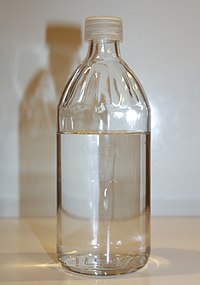
Photo from wikipedia
This work confirmed theoretically whether adsorption azeotropes can form in a binary gas mixture at a pressure P below the intersection pressure of the corresponding single-gas isotherms. The thermodynamically consistent… Click to show full abstract
This work confirmed theoretically whether adsorption azeotropes can form in a binary gas mixture at a pressure P below the intersection pressure of the corresponding single-gas isotherms. The thermodynamically consistent dual-process Langmuir (DPL) model with equal component i saturation capacities qi, js on site j and the general DPL model with nonequal qi, js on site j were used for this purpose. Relationships derived from both DPL models, in terms of the single-gas isotherm DPL model parameters, were used to answer this question. When the P range where adsorption azeotropes always exist is infinite beyond the onset P of adsorption azeotropic formation, both DPL models and experimental data showed that it is possible to form adsorption azeotropes in the corresponding binary gas mixture at pressures not only above but even below the single-gas isotherm intersection P. When the P range where adsorption azeotropes always exist is finite beyond the onset P of adsorption azeotropic formation, only the general DPL model predicts the onset P of this finite P range can be below the intersection P of the corresponding single-gas isotherms. Without theoretical proof, the thermodynamically consistent DPL model seemingly restricts this P range to be equal to or greater than the intersection P of the corresponding single-gas isotherms. For a finite P region where adsorption azeotropes always exist in a binary gas mixture, the binary selectivity inverts when traversing from below the lower onset P to the higher cessation P. Both models also showed, counterintuitively, that perfect positive energetic site matching can result in the formation of adsorption azeotropes in binary gas mixtures, not just perfect negative energetic site matching. Overall, this work provides some confirmation that it is indeed possible to form adsorption azeotropes in a binary gas mixture at pressures below the intersection P of the corresponding single-gas isotherms based on two physically sound formulations of the DPL model.
Journal Title: ACS Omega
Year Published: 2022
Link to full text (if available)
Share on Social Media: Sign Up to like & get
recommendations!